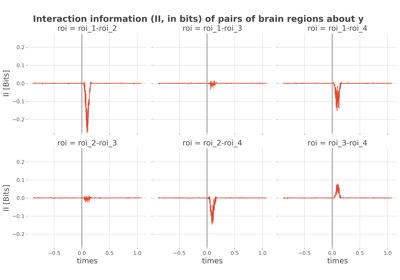frites.conn.conn_ii#
- frites.conn.conn_ii(data, y, roi=None, times=None, mi_type='cc', gcrn=True, dt=1, verbose=None, **kw_links)[source]#
Interaction Information on connectivity pairs and behavioral variable.
This function can be used to investigate if pairs of brain regions (or recordings) are mainly carrying the same information, i.e. redundant information about a variable of the task (e.g. stimulus, outcome, behavioral models) or complementary information, i.e. synergistic. The II is defined by :
\[II = I([R_{1}, R_{2}]; S) - I(R_{1}; S) - I(R_{2}; S)\]With \(R_{1}, R_{2} and S\) the brain activity of two regions and the task-related variable.
Note
Positive values of II reflects a prevalence of synergistic interactions while negative values of II reflects a prevalence of redundant interactions.
- Parameters:
- datanumpy:array_like
Electrophysiological data. Several input types are supported :
Standard NumPy arrays of shape (n_epochs, n_roi, n_times)
mne.Epochs
xarray.DataArray of shape (n_epochs, n_roi, n_times)
- ynumpy:array_like
The feature of shape (n_trials,). This feature vector can either be categorical and in that case, the mutual information type has to ‘cd’ or y can also be a continuous regressor and in that case the mutual information type has to be ‘cc’
- roinumpy:array_like |
python:None Array of region of interest name of shape (n_roi,)
- timesnumpy:array_like |
python:None Array of time points of shape (n_times,)
- mi_type{‘cc’, ‘cd’}
- Mutual information type. Switch between :
‘cc’ : if the y input is a continuous regressor
‘cd’ : if the y input is a discret vector with categorical integers inside
- gcrnbool |
python:True Specify if the Gaussian Copula Rank Normalization should be applied. Default is True.
- dt
python:int| 1 Number of successive time points to consider when computing MI. Increasing this number increase the smoothness of the results but will also increase computing time.
- kw_links
python:dict| {} Additional arguments for selecting links to compute are passed to the function
frites.conn.conn_links()
- Returns:
- interinfonumpy:array_like
The interaction information in the network of shape (n_pairs, n_times)
See also
References
McGill 1954 [14]
